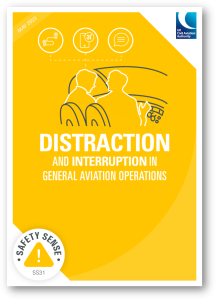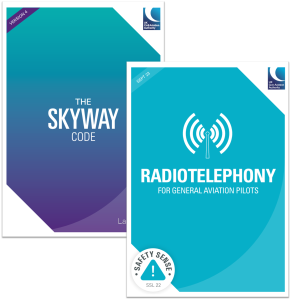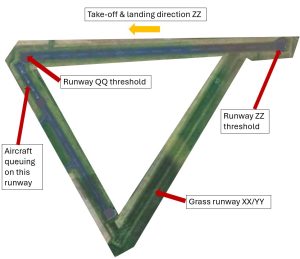A recent challenging experience during a night-rating flight took me back to a spooky experience of my youth.

It was in the 1990’s, at RAF Sealand, the base of the Air Cadets’ 631 Volunteer Gliding School. I was a teenage staff cadet, meaning that in exchange for tireless labour every weekend I would get a few instructional flights here and there, eventually becoming a ‘G1’ and be allowed to take cadets up for their first air experience flights.
I’d become quite suspicious of the un-natural handling of one of our Grob G103 ‘Viking’ gliders and had a plan for how to catch the entity responsible. I pre-flighted the aircraft, strapped into the front seat and gave the cadet on the wing-tip the instruction to level the wings. So far, so normal. After a standard launch, climb and level off, I lowered the nose to unweight the cable, released it, and trimmed for 50kts. At this point, with plenty of altitude, I gently took my hands and feet off the controls to see what would happen.
Initially, it flew straight and level (clearly my trimming was pretty good), however after flying for a short while, as predicted the poltergeist made its presence felt, and the aircraft gently banked to the left, and then levelled off again after turning through 90 degrees, all on its own, bringing us nicely onto the crosswind leg. Uncanny.

A short while later, as is the custom when a little high entering the circuit, the paranormal aircraft gently banked itself to the right, and didn’t level out again until completing a perfect 270º orbit, leaving us heading downwind straight and level. At this point, I was thinking that flying would be very relaxing if aircraft were like this all of the time, but the apparition was losing interest and the nose started to droop a little lower, with airspeed gradually creeping up…
Just then, snapping me out of my reverie came a loud noise from behind me (the first sound since getting in) “speed… SPEED! What the hell are you doing, boy?” Having caught the poltergeist red-handed, I responded: “I haven’t touched the controls since we released the cable! If you want me to fly the aircraft, then say “YOU HAVE CONTROL!”
We concluded our circuit uneventfully and had a good chat on the ground about handover protocol. The gruff, but well-loved senior instructor in the rear seat had been frustrating me for some time with his heavy presence on the controls, especially the rudder, and it made it quite difficult to understand when it was the wind nudging the aircraft, when my flying was responsible or when it was him.
But what his response in this flight showed me was more surprising than what I’d first set out to prove – he wasn’t just ‘ghosting’ the controls a little too heavily while keeping an eye on what the student was doing, he was unaware that he was actively flying the aircraft much of the time!
I’d recognised that, having flown a few hundred launches, I no longer consciously thought about separate control movements, but simply looked in the direction I wanted to go, and the aircraft would move under me to where I wanted. The same was naturally happening to this instructor with significantly more time in these aircraft than me, but with potentially worse results when he thought that he was letting students fly the aircraft.
There were 2 issues here:
1. A new solo pilot taught in this way might not really know what the aircraft feels like without another hand guiding the controls. This significantly increases the mental load on the student, trying to second-guess which forces are from air over the control surfaces versus intentional (or unintentional) deflections from the unseen instructor in the rear seat. These ‘hints’ through the controls won’t be available when the student finally flies solo, of course.
2. If the instructor moves in and out of active control without formal and explicit handover, then at a critical phase of flight (launch/landing) key seconds may be lost while the two pilots first discover their mistake in assuming that any unexpected force on the controls was/wasn’t the other person or thinking that in fact the other was in control, and then having to agree who will take charge now.
It’s no surprise that so many RAF accident reports on our coffee table at the time cited issues from ‘Cockpit gradient’ (where P2 has a higher military rank or flying experience than P1) and ‘confusion as to which pilot was flying the plane’ as significant factors in a number of avoidable accidents.
Handover Protocol, as I was taught it:
The pilot handing over will say “You have control” and the recipient takes the controls and says “I have control”, at which point the pilot that relinquished will let go of the controls completely.
One person should be in control at any time. If there is something that the instructor wants the student to feel on the controls with the instructor still in charge, then they should be formally told “follow me through” [on the controls], and the student replies “following through”.
In an emergency, if the instructor wants to seize control, it should be with the words “I HAVE CONTROL” to clearly show that they are taking control, and that they won’t be letting go again without also using the handing-back protocol.
A common thing (which I have experienced) is an instructor making a brief intervention during landing such as pulling the nose forcefully back 5 degrees, with the student not knowing if they should politely let go of the controls to let the instructor continue to fly the recovery without distraction, or to actively resume control after the momentary input?
Yoke wrestling matches in the dark
This danger played out almost verbatim for me in December 2020 (inspiring me to write this, in the hope that it might help others) while doing my first night rating sortie with a load of circuits, in which an instructor with ‘heavy hands’ (and even heavier feet) was hinting and guiding the aircraft throughout the circuit by nudging the control yoke, and then completely dominating the controls during finals and round-out each time, to the point where they were saying “feel for the ground” and I complained back “I can’t feel a damn thing with you so heavy on the controls”. At times they were like a moving cage on the controls, with me having to wrestle hard to get any movement on the controls other than where they wanted it to go.

During a particularly joyless bout of wrestling on the final turn I gave up and simply let them land it, but 10 seconds after the wheels touched down, they stopped controlling the aircraft without warning, and directional control went sketchy on the ground, and I had to dive back onto the controls to fly the touch-and-go. The rest of the flight was a tense guessing game of trying to follow what they wanted, and not knowing when their control inputs would come and go, while simultaneously trying to learn something about night flying in a busy circuit.
After the tiring and challenging flight (8 circuits, of which I didn’t land one of them), I retreated shaken and worried, questioning my own skills. However, I wondered if the instructor was fully aware of how much they were making control inputs, and how confusing that is to their students, and how dangerous it is for that control to vary between totally dominating to completely non-existent without any warning? Needless to say, I didn’t return to that instructor, and happily completed my night rating at another school without any drama.
I respect that the instructor is in charge of aircraft safety, and is a far more experienced pilot, but students also have a flight safety responsibility and should not tolerate dangerous behaviours or habits from anyone, regardless of rank.
Thanks to this reminder I have resolved that from now on whenever I get in with a new instructor (or co-pilot), I will make it my habit to set expectations from the start that naturally I want them to take over if I am putting us in danger, but that to avoid any confusion I want their hands & feet completely off the controls unless they have used clear handover protocol!
CHIRP Comment: The author identifies the risk linked to a lack of clarity over who is actually flying the aircraft and ambiguous handover/takeover protocol. Poor practice in this area can readily lead to an accident or serious incident, especially near the ground. The 4th August 2022 PA28 occurrence at Kemble is a case in point. A summary is provided below and the full AAIB report can be accessed at this link – https://www.gov.uk/aaib-reports/aaib-investigation-to-piper-pa-28-140-g-bcjn
During an attempted go-around the aircraft veered left from the runway track. The instructor was unable to establish a climb and the aircraft touched down approximately 350 m from the end of the runway, tracking approximately perpendicular to the left of the runway track. As the aircraft touched down it passed between two parked, out of use, airliners and its right wing tip struck the nose landing gear of one of the parked aircraft. The outer portion of the right wing was severed and the aircraft continued across the grass. It passed through the airfield perimeter fence, crossed the A429 road and came to rest in a ditch adjacent to the road.
There had been a confused handover of control between student and instructor that meant the go-around actions were not completed effectively. This resulted in the aircraft flying at very low height at an airspeed that was probably below the minimum power speed, leaving it with insufficient power to climb away.







